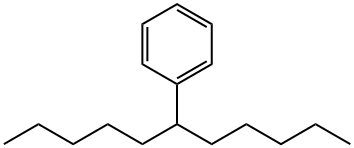
6-phenylundecane synthesis
- Product Name:6-phenylundecane
- CAS Number:4537-14-8
- Molecular formula:C17H28
- Molecular Weight:232.4
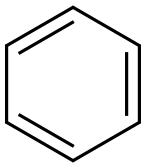
71-43-2
673 suppliers
$11.19/25ML

4537-13-7
7 suppliers
$165.00/25mg

4537-11-5
5 suppliers
inquiry

4537-14-8
1 suppliers
inquiry

2719-62-2
13 suppliers
inquiry

2719-61-1
3 suppliers
inquiry
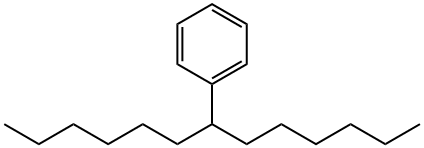
2400-01-3
4 suppliers
inquiry
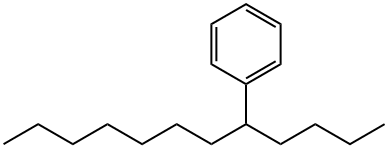
2719-63-3
3 suppliers
inquiry
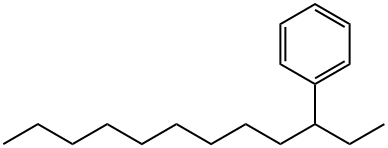
2400-00-2
11 suppliers
inquiry

2719-64-4
3 suppliers
inquiry

4621-36-7
3 suppliers
inquiry

4536-86-1
3 suppliers
inquiry

4536-87-2
3 suppliers
inquiry

4536-88-3
2 suppliers
inquiry

4534-51-4
4 suppliers
inquiry

4534-52-5
6 suppliers
inquiry
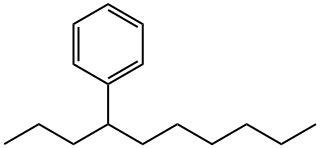
4537-12-6
2 suppliers
inquiry

4534-53-6
4 suppliers
inquiry

4537-15-9
5 suppliers
inquiry
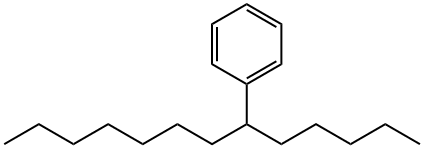
4534-49-0
2 suppliers
inquiry

4534-50-3
5 suppliers
inquiry
Yield:-
Reaction Conditions:
with petroleum fraction obtained from the dehydrogenation of a kerosene;40percent dealuminified Y zeolite, Si/Al ratio 45 in extrudate form at 135; under 30003 Torr;Product distribution / selectivity;
Steps:
1
EXAMPLE 1 Alkylation of Benzene by a Fraction that is Obtained from the Dehydrogenation of a Kerosene (Under Standard Conditions: Example for Comparison) A reactor that contains 50 cm3 of catalyst that consists of 40% dealuminified Y zeolite, with an Si/Al ratio that is close to 45 in extrudate form, is used. The operating conditions for the alkylation of benzene and a petroleum fraction obtained from the dehydrogenation of a kerosene (fraction that is obtained from the atmospheric distillation of the crude and that has a distillation range of between 150° C. and 240° C.) are standard operating conditions that are known to one skilled in the art: temperature: 135° C. pressure: 4 MPa VVH=1 h-1 benzene/olefin molar ratio: 10/1 A feedstock that contains 32% by weight of benzene and 68% by weight of kerosene fraction that is obtained from the dehydrogenation is prepared. The composition of this fraction is presented in Table 1 below: TABLE 1 Composition of the Fraction that is Obtained from the Dehydrogenation of Kerosene. Olefins Paraffins Carbon Atom (% by Weight) (% by Weight) C10 1.67 15.02 C11 3.29 29.59 C12 2.81 25.31 C13 2.23 20.08 At the outlet of the reaction zone, the products are collected, and the composition of the effluents presented in Table 2 below is obtained. TABLE 2 Composition By Weight of the Effluents of the Reaction. Compounds Content By Weight (%) Benzene 28.6 Paraffins 61.2 C10 LAB 1.8 C11 LAB 3.4 C12 LAB 2.8 C13 LAB 2.2 LAB Total 10.2 A C10 LAB is a linear alkylbenzene whose alkyl chain comprises 10 carbon atoms. It is a mixture of 2-, 3-, 4-, 5-phenylalkanes whose alkyl chain comprises 10 carbon atoms. A C11 LAB is a linear alkylbenzene whose alkyl chain comprises 11 carbon atoms. It is a mixture of 2-, 3-, 4-, 5-, 6-phenylalkanes whose alkyl chain comprises 11 carbon atoms. A C12 LAB is a linear alkylbenzene whose alkyl chain comprises 12 carbon atoms. It is a mixture of 2-, 3-, 4-, 5-, 6-phenylalkanes whose alkyl chain comprises 12 carbon atoms. A C13 LAB is a linear alkylbenzene whose alkyl chain comprises 13 carbon atoms. It is a mixture of 2-, 3-, 4-, 5-, 6-, 7-phenylalkanes whose alkyl chain comprises 13 carbon atoms.
References:
Briot, Patrick;Guillon, Emmanuelle;Hugues, Francois;Marion, Marie-Claire US2005/187417, 2005, A1 Location in patent:Page/Page column 4

108-86-1
496 suppliers
$10.00/5g

4537-14-8
1 suppliers
inquiry

927-49-1
145 suppliers
$13.43/1gm:

4537-14-8
1 suppliers
inquiry
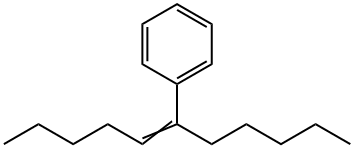
89579-51-1
0 suppliers
inquiry

4537-14-8
1 suppliers
inquiry

